Toilet drain pipe: what is it for + installation and connection nuances
The drain pipe is a component of the sewer system, without which it is impossible to equip a bathroom. It is designed to connect the sewer riser to the atmosphere, preventing the formation of wastewater and the appearance of an unpleasant odor in the bathroom.
A toilet drain pipe installed in the toilet room prevents vacuum from occurring in the sewer system and ensures uninterrupted operation of the water valves. In our material we will understand what kind of fan pipes there are, and also tell you about the rules for their installation.
The content of the article:
Types of fan products
Fan pipes are classified according to the construction material used in the manufacture of the product.
The classification divides fan pipes into 2 types:
- metal;
- plastic.
The metal (cast iron) version can be installed in a sewer system made of a similar material. Plastic products can be installed in both plastic and cast iron pipelines.

When installing a plastic element, you get a flexible sewer pipe, a monolithic elbow or a compact adapter. Cast iron products are not flexible and do not have a variety of shapes.
What is the vent pipe used for?
According to the building regulations in force today, the process of constructing a sewerage system for a one-story house can be carried out without a drain pipe.This is due to the insignificant amount of one-time drains.
If the building consists of two or more floors or the housing is equipped with several bathrooms, then in order to ensure stable pressure in the sewerage system, a drain pipe is required. This element connects the riser to the atmosphere, maintaining stable atmospheric pressure even in the event of a volumetric release of water from the toilet tank, which provokes a vacuum in the outlet line.

If there are several toilet rooms in a residential building, then the situation changes radically and a vent pipe installed on the toilet is a vital necessity.
This rule applies in the following cases:
- the house has 2 or more levels, which are equipped with a sewer system and water supply;
- cross-sectional diameter of the sewer riser - 50 mm;
- there is a swimming pool or water equipment inside the building that discharges a significant amount of waste into the sewer system;
- The septic tank is located close to the house, which can cause a rather unpleasant odor.
In the above cases, vacuum without a drain pipe can lead to the rapid emptying of siphons under the toilet or sink, which will ensure direct contact of the “atmosphere” of the septic tank with the microclimate of the room.
Thus, the installation of a fan product in the sewer system ensures stable pressure in the outlet pipeline and preserves the integrity of water drains in siphons under special drain openings that cut off the unpleasant aroma of septic tanks from the home microclimate.
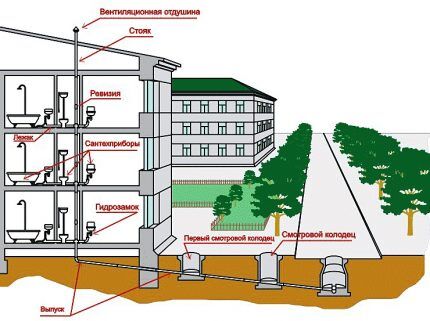
The construction of a sewerage and ventilation system with waste pipes is rational in the following cases:
- when installing a sewer riser in a private house with a diameter of 50 mm;
- if the house has two or more floors, each of which has bathrooms;
- a private house is equipped with plumbing equipment, for example, a swimming pool, generating powerful water flows;
- An autonomous sewerage system is located next to the residential building.
Usually toilet installation performed on a sewer pipe having a typical diameter of 110 mm. The cross-section of the drain hole in the tank is 70 mm. As a rule, a pipeline with a diameter of 50 mm is connected to the bathroom. It is connected to a riser with a siphon cross-section of no more than 110 mm.
It follows from this that when one bath or toilet is operating, the internal diameter of the riser will not be completely blocked.

A washbasin, sink or household appliances (dishwasher, washing machine, etc.) connected to the sewer system are not capable of significantly changing the volume of a one-time drain.
The one-time waste of the above-mentioned devices is insignificant, so they cannot radically affect the situation. In these cases, the drain pipe is mounted to the toilet at the request of the property owner.
Installation rules and features
Fan pipes are made from sewer pipes of the required diameter.They serve as a continuation of the riser in the bathroom and end with an entry into a special channel equipped for ventilating the sewer system.
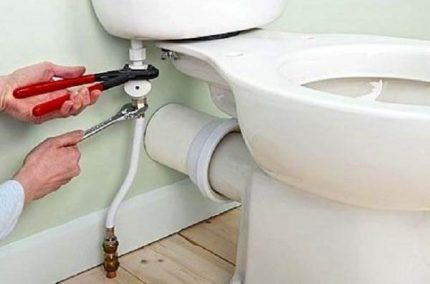
Connecting a vent system allows you to successfully solve the current problem of unpleasant, pungent odors in the toilet when the sewer and ventilation systems are fully operational. This is due to the small size of siphons in modern plumbing fixtures, which can result in an insufficient supply of water (hydraulic seal).
If a shower drain or plumbing fixture is not used for more than 2 days, this can lead to the water seal drying out, which will cause the unimpeded penetration of air from the sewer into the bathroom. At the same time, the fan pipe not only effectively sucks in air, but also ventilates the sewerage pipeline.
When warm air rises through the riser, a vacuum occurs, due to which it partially enters the atmosphere through a previously dried siphon.

According to building codes, the fan pipe must be installed in a warm room; if necessary, the product must be insulated. If it freezes, the fumes will not dissipate quickly or efficiently. For this reason, after a year of use, the upper part of the element will be covered with a greenish coating.
When installing a waste pipe, you must follow two basic rules:
- The diameter of the product must be greater than the diameter of the riser on which the sewer pipe is mounted (regardless of the material used in the manufacture of the pipe).
- It should end 40-50 cm from the edge of the roof ridge, so unpleasant odors will be quickly released into the atmosphere.
The system outlet must be located outside the residential area. More precisely, the drain pipe for the plumbing fixture (toilet) should extend beyond the bathroom and stretch through the attic to the roof of the building. Otherwise, the foul odors from your septic tank will permeate your living space.
What is required to install a toilet?
The connection diagram for a plumbing fixture to a general sewer system involves connecting the toilet to the pipeline using pipes, bends, corrugated or eccentric cuffs.
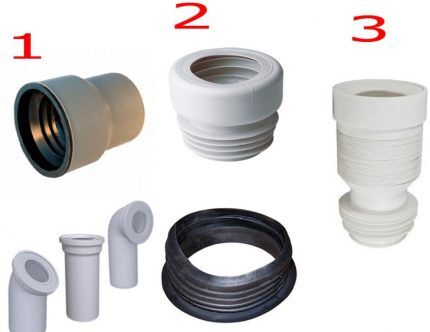
It should be taken into account that the installation of any toilet model using reliable and durable cuffs has a number of requirements:
- it is strictly forbidden to cut pipes and change their geometric shape;
- corrugated cuffs can be freely extended in length, as well as bent at the required angle;
- The eccentric cuffs must be rotated relative to the axis, this allows you to compensate for the deviation from the alignment of the plastic pipes connected to each other.
Making a pipeline connection using pleated cuff has its advantages. This is a unique opportunity to connect the toilet to the general sewer system in hard-to-reach places. In these cases, the sewerage system is equipped with various receiving sockets.
Instructions for installing the riser
When replacing a pipeline in a country house or apartment, you must first dismantle the sewer system. Products made of cast iron are considered obsolete, so they must be replaced with plastic counterparts, following certain rules.
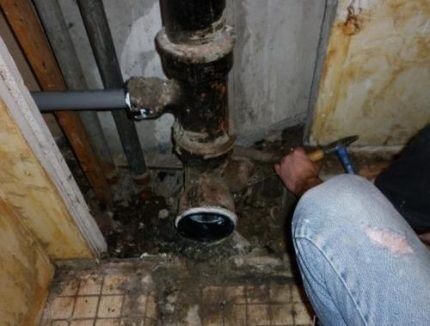
Dismantling is carried out by disconnecting the sewer riser and then disconnecting all structural elements.Before replacement, it is recommended to consult with specialists, which will allow you to find out whether replacing an element of a cast-iron riser with a plastic one will lead to unpleasant consequences, expressed in a decrease in the strength and reliability of the sewer system.
The new pipe is installed from the lower point of rigidity, located in the area of the main riser. Installation in a country house begins with the area where the building's foundation is located. It is necessary to drill holes in the supporting structures, after which a pipe with a diameter of 110 mm is installed and secured with clamps. After installing the plumbing fixture, a special outlet is connected to it.
When installing the riser, it is necessary to use exclusively metal clamps, which will ensure the reliability of the structure and will reduce deviations from the marking lines that arise during the assembly process.
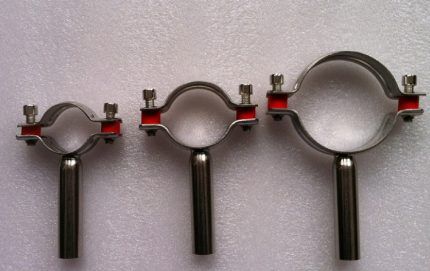
The pin on the metal clamp has a functional screw structure that allows you to accurately adjust the elements being connected.
Thermal insulation and sound insulation of pipes
When installing plastic elements, we must not forget about important measures to protect the system - noise insulation and thermal insulation of the pipe. Thermal insulation is carried out using a tubular cover made of foam insulation, which is worn from the outside.
To arrange the sound insulation of the system, the contact point between the interfloor slab and the pipes is filled with polyurethane foam or other sealed material.
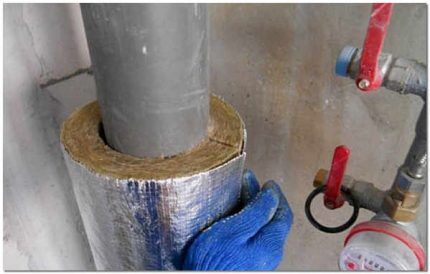
Sound insulation of a fan pipe can be carried out using a mineral slab or special polyurethane foam. Polyurethane foam is more often used, which is easier to use, however, if the structure is dismantled, it will not allow it to be put back together.
Check valve for vent systems
During the installation process, the fan pipe is inserted into the previously prepared ventilation duct. If the project provides for the presence of a minimum number of ventilation risers, then the outlet for the toilet is routed horizontally to the wall, without deteriorating the interior of the bathroom.
An important element of the system deserves special attention - the check valve, whose functions include:
- preventing waste from returning back into the toilet;
- the valve prevents rodents from entering the sewer system;
- correcting the situation in case of incorrect pipe slope;
- preventing mechanical impurities from returning to the toilet.
If the check valve is installed internally, the pipe should first be cleaned and thoroughly degreased. Then a special insert is installed - it must be purchased in advance, since it is not included with the check valve.
When installing the valve, it must be taken into account that its location should be opposite to the return flow, and the petals are bent towards the plumbing element.
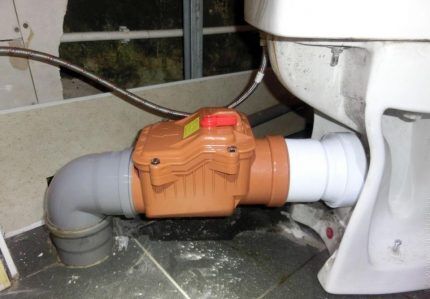
When installing the valve, do not use lubricants or silicone products, even if they are intended for sewer systems. The installation process must be carried out exclusively dry.
If the sewer pipe has a typical diameter of 110 mm, then valve installation requires the use of a special adapter. If you plan to connect to a gray pipe with a sawn-off socket, the valve is installed in the pipe.
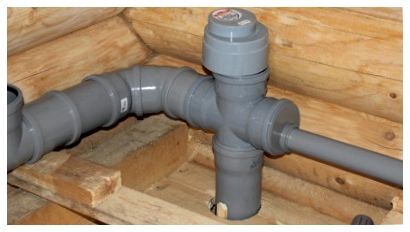
When the toilet flushes, the valve cover opens, after which it closes automatically using a spring made of stainless steel. Due to this design, the lid does not open from the outside with fecal matter, which prevents it from falling back into the toilet.
The tightness of the connection between the valve and the sewer pipes is achieved using rubber rings. The valve has a long service life (more than 50 years).
Connecting a toilet without corrugation
If the owner decides not to use corrugation when connecting a plumbing fixture, it is necessary to adhere to the basic rules: it is necessary to use an adapter or pipe; connecting the toilet to the adapter is carried out in different ways, depending on the release of the plumbing fixture.
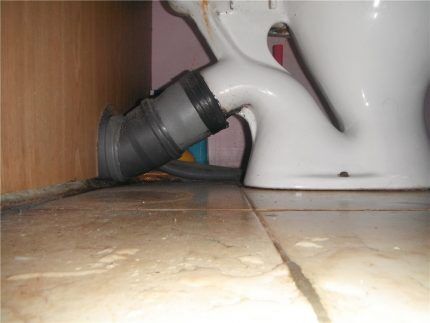
Depending on the internal design, toilets are classified into 3 types, which also differ in installation and connection features:
- Plumbing equipment with oblique outlet.The plumbing fixture is installed into the pipe at an angle of 90.
- Plumbing equipment with vertical outlet. Plumbing installation is carried out on the floor.
- Plumbing equipment with horizontal outlet. The products are installed into the sewer pipe horizontally or with a slight slope.
If the plumbing outlet and the sewer network inlet do not coincide, then you need to install adapter pipes bent at the desired angle or select the optimal toilet model.
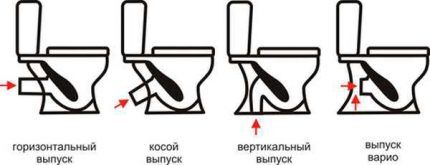
Before choosing the optimal design, it is worth considering the installation features of each type of plumbing equipment.
Installation of a toilet with vertical outlet
Similar models of plumbing fixtures are widely used in European countries. This is due to the fact that a vertical outlet pipe and a siphon located in the plumbing bowl are built into the plumbing equipment. The convenient design allows the product to be installed at any distance relative to the wall.
Installation of plumbing fixtures with a vertical outlet is relatively simple:
- markings are made on the floor of the toilet room;
- According to the markings, a screw flange equipped with a special lock is installed;
- the sewer pipe is mounted in a round hole located in the center of the flange;
- The toilet is mounted on the previously installed flange, then it is turned until the equipment is completely fixed.
The outlet pipe is equipped with an O-ring.Thanks to the presence of this element, the pipe is automatically pressed tightly against the sewer pipe. Read more about connecting a plumbing product with a vertical outlet. Further.
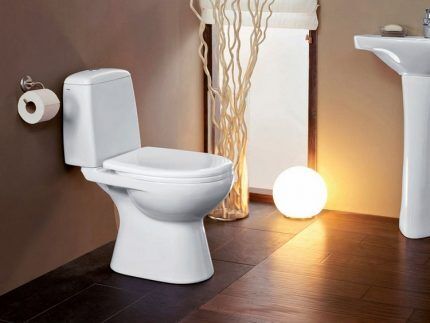
Installation of plumbing fixtures with horizontal outlet
Connecting toilet models with direct (horizontal to the floor) outlet is relevant for the conditions in our country. This is due to the fact that the bathroom is tied to a specific wall of the toilet room due to the specific layout of sewer pipes in typical Russian houses.
Since the outlet in these models is directed backwards, it is located at the rear of the product. The outlet pipe is attached to the pipe using a sealing collar.

During installation, special attention should be paid to securing the plumbing equipment to the bathroom floor. The bowl legs of sanitary ware with a horizontal outlet have specially made holes designed to securely fix the toilet to the floor.
The connection of direct outlet plumbing equipment ends with the installation process, during which screws and dowels are used. Fastening must be done carefully, since if the screw is pulled too hard, the integrity of the sanitary ware surface can be damaged.
Installation of plumbing equipment with oblique outlet
The process of installing and connecting plumbing equipment with an oblique outlet is carried out in stages:
- Before connecting the plumbing to the sewer system, the outlet of the device with the grooves located inside should be lubricated with a mixture of red lead and drying oil (or sealant).
- A resin strand must be carefully wound on top. The tip of the 0.5 cm long shoot should remain free, since the ends of the strand can get into the hole and cause a blockage.
- The wrapped resin strand is lubricated with red lead.
Then the toilet is installed, during which the outlet branch is fixed in the socket of the sewer pipe.
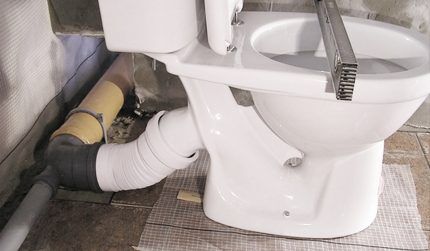
Installation of plumbing equipment with oblique release - a simpler process due to the absence of a fixed connection point in a certain place. If, when installing a sewer system, the outlet socket is not positioned accurately, this is not considered a problem.
Features of repair of fan systems
Installation of the internal sewerage system is carried out “in the socket”. This greatly simplifies the process of installing and dismantling all pipeline elements.
Repair work is necessary when there is physical damage to a drain or sewer pipe. Due to the excellent rigidity (pipe bending resistance is 80 MPa) and the long service life of the plastic (up to 60 years), there is a low probability of physical damage to the pipes.
When repairing sewer pipes, the technician must take into account the following rules:
- the end of the drain pipe is positioned in such a way as to ensure effective dispersion of unpleasant odors;
- the diameter of the pipe must be the same or larger than the riser on which the installation is being carried out;
- lay the pipe in warm rooms, and complete the installation in a cold zone, since the temperature difference provokes a pressure difference in different parts of the pipe.
Repair work involves connecting a waste pipe to a sewer riser. At the same time, vacuum valves are installed on other risers - rubber seals equipped with springs.
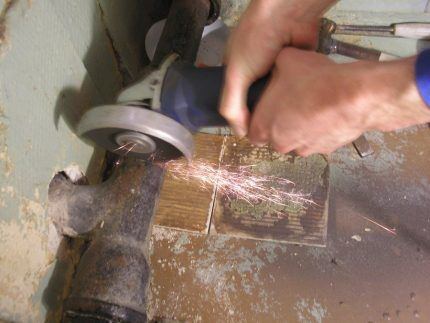
During operation, the sewer system creates a vacuum in the valve, as a result of which it opens and sucks air from the room. After stabilizing the pressure in the riser, a special spring automatically closes the check valve, preventing the unpleasant odor from escaping into the atmosphere.
Conclusions and useful video on the topic
The videos are useful for a general understanding of how the sewer system works in your home.
The role of the drain pipe in the sewer system and the operating principle of vacuum valves:
Replacing a cast iron toilet pipe with a plastic one:
How to replace the tee yourself:
We figured out what a drain pipe is and what its role is in the sewerage and ventilation system. You can arrange it yourself, but if difficulties arise with installation or calculations, it is better to contact specialists.
If, after studying the material, you have questions or you have valuable information on the installation of waste pipes, please share it with our readers. Leave your comments, ask questions, share your experience.




When installing toilets, it is customary for aesthetic reasons to try to hide all connections and communications in the walls and floor. At the same time, they often do not take into account that difficulty in accessing pipes and the lack of daily monitoring of their condition can cause a real communal disaster. I had a chance to witness that a defect in the wiring in the fifty-ruble flexible wiring, which they managed to hide in the wall cladding, led to the apartment owner paying for repairs in 2 apartments below.
For some time now, an unpleasant sewer smell began to periodically appear in the bathroom. I’ve already washed the toilet probably ten times, filled it with cleaning agents - it helps temporarily, then again... I don’t understand whether it’s the smell from the ventilation from the neighbors, or from the toilet. They suggested that this could be due to an incorrectly made drain pipe. I don’t want to call a plumber just yet (I assume that he will say “everything needs to be redone. I’m not mentally ready for this yet), I want to try to understand on my own what the problem is. Are there any external signs that something is wrong with the pipe?
First of all, I want to say that it is better to call a plumber; you won’t pay a lot of money for diagnostics and calling. But he will know the exact cause of the unpleasant odor in the toilet. And there you will decide to eliminate it yourself or still involve a specialist in the solution.
Let's go through the main reasons that can cause an unpleasant odor in the toilet:
— The water level in the siphon has shifted, causing sewer gases to pass over the water plug;
— The corrugated pipe has stretched; due to the sagging of the pipe, an unpleasant odor can penetrate;
— Incorrect bend of the corrugation, perhaps the bend of the corrugation has changed (something has touched it), which provoked the appearance of an unpleasant odor;
— A clogged siphon, if you have a combined bathroom, then this may be one of the reasons for the unpleasant odor.
I have named only the main problems that you can detect on your own. But it’s better to call a specialist; depending on the cause of the problem, repairs will cost you from 10 to 30 dollars.
At our dacha in a two-story house, the toilets are arranged one below the other, mine goes to the autonomous station. The sewer riser ends exactly at the toilet on the second floor (from the upper toilet it immediately goes down to the lower one - and then leads into the septic tank. They did not immediately provide for the drain pipe to be brought to the roof. There was a smell in the toilet on the second floor. They made a waste pipe along the outside of the house. In In the end, everything got even worse - there is a wild smell of methane in the second floor toilet. The water seals are not blown off, there is water in the toilet all the time, I check. But this smell! What did we do wrong? What is the reason for this? Will bringing the sewer riser to the toilet will solve the problem? roof? And where should a check valve be installed in this case?
Good afternoon We recently bought an apartment on the 5th floor (a building with 5 floors), the previous owner did not say anything about the smell. But in the bathroom, and then throughout the apartment, the smell of sewerage spreads. In the summer we will be renovating the bathroom (shared bathroom). We are looking for the cause of the smell. Question. Could the drain pipe be the cause of the smell? It ends in our bathroom, that is, it is not led out into the attic. In this case, what should we do? This is done throughout the house, I asked the Manager. But this is not correct, who should remake this system? At whose expense?